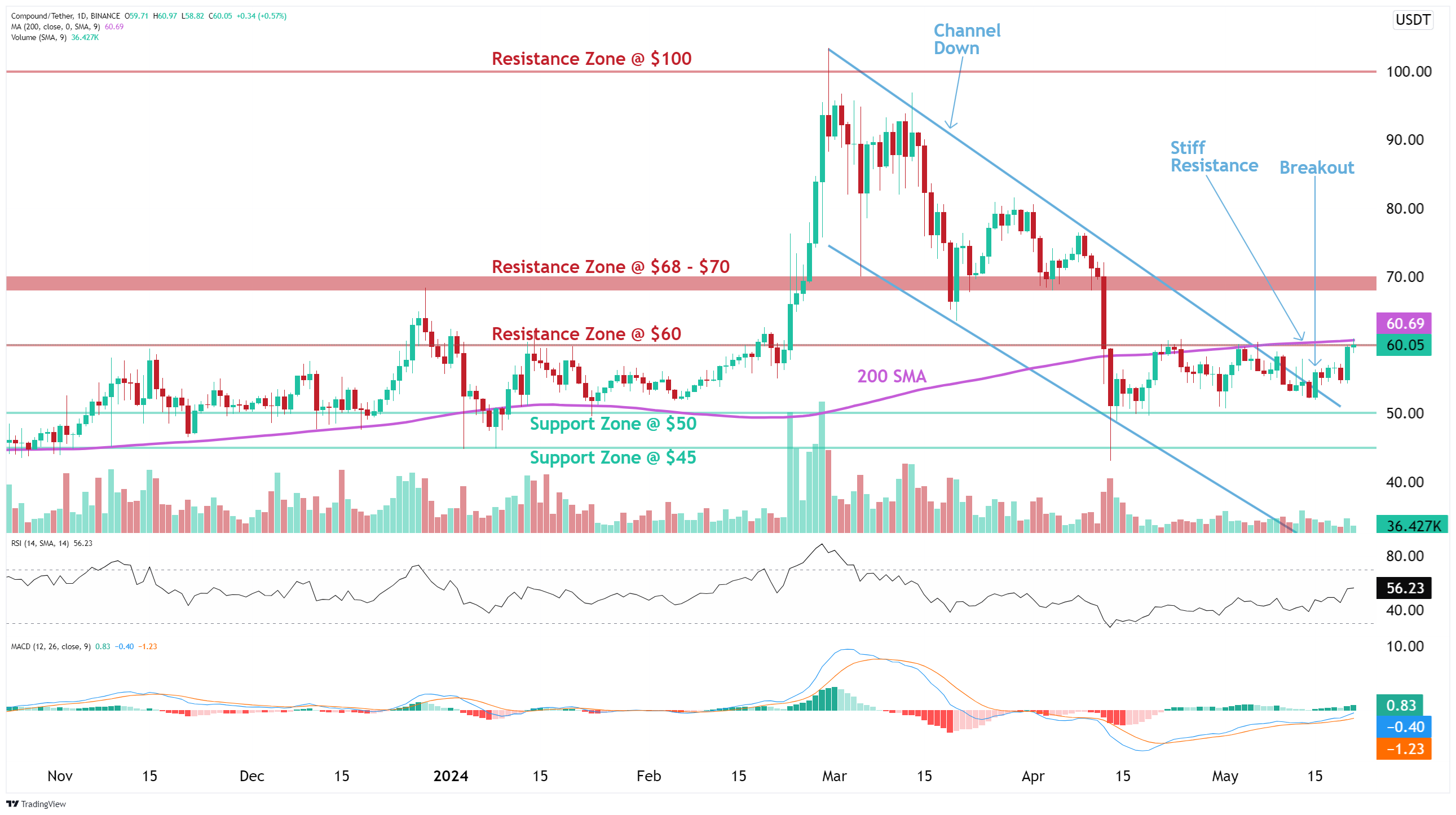Compound (COMP) Analysis
Compound (COMP) Analysis
In addition to automated chart patterns, altFINS’ analysts conduct technical chart analyses of top 30 cryptocurrencies. We call these Curated Charts and they evaluate 5 core principals of technical analysis: Trend, Momentum, Patterns, Volume, Support and Resistance.
Compound (COMP) technical analysis:
Trade setup: Trends are mixed. It broke out of a Channel Down pattern but needs to confirm that by breaking above horizontal resistance ($60) and 200-day MA ($60). We wait for a confirmation, after which, there’s +15% upside potential to $68-70. This is a riskier trade setup because it’s a trend reversal not a trend continuation setup. It’s against the overall downtrend. (set a price alert).
Pattern: Price was trading in a Channel Down pattern. With emerging patterns, traders who believe the price is likely to remain within its channel can initiate trades when the price fluctuates within its channel trendlines. With complete patterns (i.e. a breakout) – initiate a trade when the price breaks through the channel’s trendlines, either on the upper or lower side. When this happens, the price can move rapidly in the direction of that breakout.
Trend: Uptrend on Short-Term basis and Downtrend on Medium- and Long-Term basis.
Momentum is Mixed as MACD Line is above MACD Signal Line (Bullish) but RSI ~ 50 (Neutral).
Support and Resistance: Nearest Support Zone is $50, then $45. The nearest Resistance Zone is $60, then $68 – $70.
See live Compound (COMP) chart here
See more curated charts of coins with technical analyses.

Recent news and research:
DeFi Market Sees Strong Bounce Back, COMP and AAVE woo Institutions
Is there enough momentum for UNI, COMP, MKR, and AAVE?
On-Chain Metrics: DeFi Token Compound (COMP) Registers 45% Rally In Three Days
Find more real-time news here.
What is Compound (COMP)?
Find full description and news on altFINS platform.
Overview
Compound is a lending platform built on Ethereum that enables users to permissionlessly borrow or lend from a pool of assets. Rather than interest rates being set by individuals, they are determined algorithmically based on the proportion of assets lent out.
History
Compound was started with the goal of creating more robust credit markets, a necessary component of any functional financial system. While centralized services can offer these facilities, they are trust-based systems that compromise on the decentralized nature of cryptoassets. This can be solved by creating trustless peer to peer protocols, however, they require more active participation from borrowers and lenders needing to be matched. Compound looks to solve these problems by creating a pooled loan model that allows users to deposit into a pool that borrowers can then withdraw from provided they post sufficient collateral. This means loans do not have any maturity and users do not need to wait for a counterparty since they are interacting with the aggregate of all users.
Compound allows users to earn interest on their holdings, short assets they think are overvalued, or obtain assets they need to utilize without having to purchase them. Gradual decentralization Compound initially began as a tokenless protocol. Upgrades and changes were made unilaterally by the Compound Labs team. The protocol was still non-custodial but there was a centralized entity that retained administrative privileges. In order to remove themselves from this position, the team introduced COMP, a token used to govern the protocol. After several stages, Compound is now fully controlled by COMP holders with no remaining privileges held by Compound Labs.
Technology
Compound pools are created by users supplying assets in return for ERC-20 “cTokens” which entitle holders to a fixed percentage of the overall pool. As borrowers withdraw funds and repay them with interest, the total pool size increases giving cToken holders the right to a growing balance meaning they are continuously earning interest. Borrowers can withdraw an amount up to their total capacity equaling the sum of the token balance multiplied by the collateral factor which is a number 0-1 representing the portion that can be borrowed. An asset with a
high collateral factor means it is a better form of collateral and typically a relatively liquid, large market capitalization asset. In the event the collateral decreases in value past the close factor, then third parties can purchase the underlying collateral minus a liquidation discount (currently 5%) in order to repay the debt. The interest rate paid on the debt is determined by market forces. As the ratio of borrowed assets to total pool size increases, the interest rate will increase accordingly to incentivize more lenders to come in and ensure the pool doesn’t run out.
Usage Details
The COMP token is used to propose and vote on changes to the protocol. It was explicitly not marketed as an investment, however, it is widely believed token holders will eventually vote in a mechanism of value capture providing them with some claim on the cash flows of the system.
Supply Curve Details
A total of 10 million COMP tokens were created and distributed as follows: 4,229,949 Users of the protocol (over 4-year period) 2,396,307 Shareholders of Compound Labs, Inc. 2,226,037 Founders & team(4-year vesting) 372,707 Future team members 775,000 Allocated for the community to advance governance through other means
Asset profile is provided by messari. Original version can be found at Messari